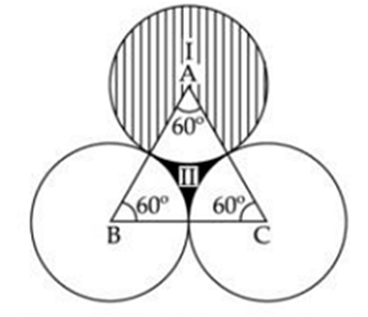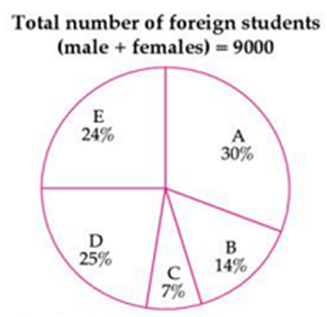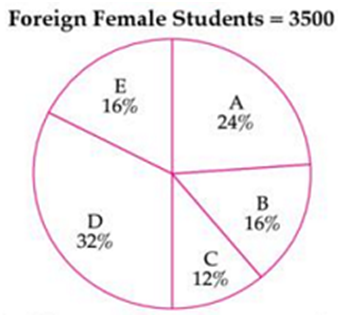
Reserve Bank of India Officer Exam., 2016
Held on 4-9-2016
Quantitative Aptitude
(2nd-Shift)
Directions – (Q. 1 to 5) Find the wrong number in the series ?
1. 18.3 20.6 16 22.9 13.7 2.2 11.4
(A) 2.2
(B) 16
(C) 22.9
(D) 20.6
(E) 13.7
2. 2 4 11 37 151 771 4633
(A) 151
(B) 4
(C) 37
(D) 771
(E) 11
3. 188 154 140 132 128 126 125
(A) 154
(B) 132
(C) 128
(D) 140
(E) 126
4. 391 394 399 411 431 461 503
(A) 399
(B) 411
(C) 394
(D) 461
(E) 431
5. 9 5 6 5 23 61 183
(A) 61
(B) 23
(C) 10.5
(D) 6
(E) 5
6. A, B and C are partners in a business. Their capitals are respectively Rs. 5000, Rs. 6000 and Rs. 4000. A gets 30% of the total profit for managing the business. The remaining profit is divided among three in the ratio of their capitals. In the end of the year, the profit of A is Rs. 200 more than the sum of profits of B and C. Find the total profit.
(A) Rs. 4500
(B) Rs. 5200
(C) Rs. 1800
(D) Rs. 3000
(E) Rs. 2100
7. A shopkeeper purchased 15 kg of variety A rice at Rs. x per kg and 10 kg of variety B rice at Rs. ‘x + 5’ per kg. The shopkeeper sold the whole quantity of variety A rice at 10% profit and that of variety B rice at 20% profit. The total selling price of variety A rice was Rs, 30 more than that of variety B rice. Had the two varieties been mixed and sold at an overall profit of 20%, what would have been the selling price (per kg.)
(A) Rs. 26.40
(B) Rs. 23.20
(C) Rs. 24.20
(D) Rs. 25.00
(E) Rs. 28.80
Directions- (Q. 8 to 12) In these questions, there is a question with two quantities and answer as :
(A) Qty. I : ≥ Qty II
(B) Qty. I : > Qty II
(C) Qty. I : < Qty II
(D) Qty. I = Qty. II or relationship can not be established.
(E) Qty I ≤ Qty. II
8. 1 > a > 0 > b
Quantity I :

Quantity II : ![]()
9. There are three positive numbers a, b and c. .The average of a and b is less than the average of b and c by 1.
Quantity I : Value of c.
Quantity II : Value of a.
10. Three equal circles are drawn on a triangle ABC, with pints A, B C as the centers. Radius of each of the circle is equal to half of the side of the triangle ABC (Figure not to the scale).

Area of shaded region 
Quantity I : The area of the shaded region II (in cm2)
Quantity II : 30 cm2
11. Ram invested Rs. P in scheme A and Rs. 2P in scheme B, for two years each. Scheme A offers simple interest p. a. Scheme B offers compound interest C9 compounded annually) at the rate of 10% p.a. Respective ratio between the interest earned from scheme A and that earned from scheme B was 8 : 21.
Quantity I : Rate of interest offered by scheme A.
Quantity II : Rate of interest offered by scheme C (simple interest p.a.), when Rs. 1600 is invested for 3 years earns an interest of Rs. 384.
12. Rutuja bought two articles-article A at Rs. x and article B at Rs. x + 50. She sold article A at 0% profit and article B at 10% loss, and earned Rs. 35 as profit on the whole deal.
Quantity I : Profit earned by Rutuja on selling Article A (in Rs.)
Quantity II : Loss incurred (in Rs.) when an article which costs Rs. 480 is sold at 20% loss.
13. Arun and Bhadra are brothers. In how many years from now will Bhadra’s age be 50 years ?
(I) The ratio of the current ages of Arun and Bhadra is 5 : 7 respectively.
(II) Bhadra was born 10 years before Arun.
(III) 5 years hence. Arun’s age would be three-fourth of Bhadra’s age at that time.
(A) Any two of the three
(B) Only II and either I or III
(C) All I, II and III
(D) Only II and III
(E) Only I and III
14. A right-angled triangle is inscribed in a given circle. What is the area of the given circle (in cm2) ?
I. The base and height of the triangle (in cm) are both the roots of the equation x2 – 23x + 12 = 0
II. The sum of the base and height of the triangle is 23 cm.
III. The height of the right-angled triangle is greater than the base of the same.
(A) III and either only I or only II
(B) All I, II and III
(C) Only II and III
(D) Only I
(E) Either I or II
15. What is the ratio between the marked price of two identical items, A and B, which had been purchased at the same price ?
I. Item A was sold at a profit of 20%, while item B was sold at a loss of 10%
II. Item A was sold at a discount at ![]() The percentage by which item B’s cost price had been marked up is the same as the profit % earned on selling item A.
The percentage by which item B’s cost price had been marked up is the same as the profit % earned on selling item A.
III. The overall profit earned on selling items A and B was Rs. 576
(A) Any two of the three
(B) Only II and III
(C) All I, II and III
(D) Question cannot be answered even with the information in all three statements.
(E) Only II
16. Three workers A, B and C complete a given piece of work within different time spans, while working individually. What is the ratio of difference of C and B respectively ?
I. A takes 100% more time than C to complete the given piece of work.
II. B completes the given piece of work within 8 days.
III. B takes 2 days less than A to complete the given piece of work.
(A) Question cannot be answered even with the information in all three statements.
(B) All of the three
(C) Only II and III
(D) II and either only I or only III
(E) Only I and III
17. What is the three-digit number having each digit different from the other ?
I. Each of the digits of the given number is a multiple of 3.
II. The digit in the unit’s place is 50% less than that in the hundred’s place.
III. None of the digits is zero.
(A) All I, II and III
(B) Only I
(C) Only I and II
(D) Only III
(E) Only II
18. The respective ratio between the time taken by a boat to travel the same distance downstream in stream A and that in stream B is 8 : 7. The speed of the boat is 12 km/h and the speed of stream A is half the speed of stream B. What is the speed of stream B (In km/h)
(A) 5
(B) 2
(C) 3
(D) 4
(E) 6
19. To complete a project, 18 women take 4 more days than the number of days taken by 12 men. If eight men complete the project in 9 days, how much work will be left when 15 women and 12 men together work for 3 days ?
(A) ![]()
(B) ![]()
(C) ![]()
(D) ![]()
(E) ![]()
Directions – (Q. 20 to 24) Refer to the pie charts and answer the given question :
Data regarding number of foreign students (male + female) from different countries : A, B, C, D and E, studying in higher education level in the country XYZ in the year 2014.


20. What is the respective ratio between the total number of male students from countries B and C together and total number of students (male + females) from the same countries together ?
(A) 14 : 27
(B) 25 : 14
(C) 4 : 9
(D) 5 : 6
(E) 13 : 27
21. What is the average number of male students from countries C, D and E ?
(A) 910
(B) 915
(C) 900
(D) 945
(E) 980
22. The total number of female students from country A and B together is what per cent of male students from country A ?
(A) 60
(B) 59.5
(C) 65.29
(D) 75.27
(E) 50
23. Female students from country E is what per cent approximately more than those from country C ?
(A) 45
(B) 50
(C) 40
(D) 60
(E) 30
24. Male students from country E in the year 2015 were 20% more than those from the same country in the previous year. If the male students from country E constituted 60% of the total students (male + females), in the year 2015, how many foreign students from country E in the same year were females ?
(A) 1400
(B) 1480
(C) 1280
(D) 1220
(E) 1260
25. Abhay rolled a pair of dice together. What is the probability that one dice showed a multiple of 2 and the second dice showed neither a multiple of 3 nor 2 ?
(A) ![]()
(B) ![]()
(C) ![]()
(D) ![]()
(E) ![]()
Directions – (Q. 26 to 30) Study the table and answer the given question :

Note – Few data are missing (indicated by). You need to calculate the value based on given data, if required to answer the given question.
26. Only 40% and 20% of females were graduates in villages A and C respectively. If female population of villages A and C were equal, what was the respective ratio of number of non-graduate females (including illiterate females) in villages A and C ?
(A) 81 : 107
(B) 90 : 107
(C) 90 : 121
(D) 40 : 49
(E) 45 : 49
27. If in village E, 40% of male literates and 40% of female literates were graduates, what per cent of total population were graduates ?
(A) 32
(B) 28
(C) 35
(D) 40
(E) 30
28. In village B, the number literate females was what per cent less than the number of literate males ?
(A) 12.5
(B) 30
(C) 32
(D) 40
(E) 45
29. The total number of literates (Male and Female in Village D was 4320. If the number of illiterate females was 320 more than the number of illiterate males, what was the male population of the village ?
(A) 3200
(B) 3000
(C) 2800
(D) 3600
(E) 3500
30. In village C, the number of females increased by 20% from 2011 to 2015. If the number of literate females was equal in 2011 and 2015, what per cent of female population of village C was literate in 2015 ?
(A) 66
(B) 54
(C) 60
(D) 72
(E) 56
Latest Govt Job & Exam Updates: